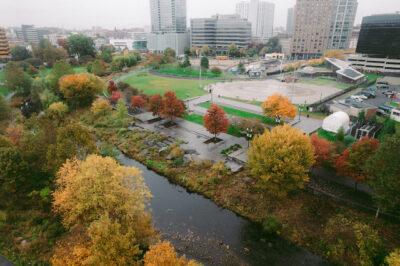A new look at Stamford’s revitalized Mill River Park

Recently, Mill River Park in Stamford hosted a special architecture and design tour, offering attendees an inside look at the park’s transformation. On the tour, Mill River Park Collaborative’s President and CEO Nette Compton, ASLA; Board Chair Arnold M. Karp; and Vice Chair Ryan Salvatore, AIA, guided guests through the park’s history, architecture and ongoing significance to the Stamford community.
Founded in 2003, the nonprofit collaborative has overseen the design, construction, maintenance and programming of the park, with the goal of providing opportunities for the community to experience nature in the heart of the city. The year-round recreational, educational and cultural programming is free, enhancing Mill River Park’s role as a hub for connection, relaxation and environmental learning.
The tour traced the park’s roots from Stamford’s nearly century-long dream of creating a downtown park along the banks of the Mill River. In 2000, a study by the U.S. Army Corps of Engineers endorsed the removal of the historic Mill River Dam, leading to the restoration of the natural stream channel, the return of native fish species and the establishment of wetlands. The park design blends cutting-edge bioengineering with native plantings, earning it recognition as one of the “Great Places in America” by the American Planning Association in 2018.

Architectural highlights include the open-air pavilion and the Brownstein | Selkowitz Carousel Pavilion, both of which marry modern design to the natural landscape. These sustainable structures, along with the Leed Platinum Certified Whittingham Discovery Center, offer a balance to the city’s urban environment not only for the business community but particularly for underserved youth and their families.